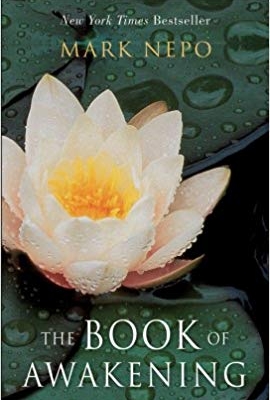It has been said that every moment and every day offers us a fresh new beginning. “In the beginner’s mind, there are many possibilities, but in the expert’s mind there are few.” —Shunryu Suzuki
Someone recently called me a master workshop facilitator and I responded by saying I always feel like I am at the beginning because I am always learning my craft. I have been tracking what enlivens me (art & culture, connecting with people I enjoy being with, and being in nature) and what drains my energy. After taking a social media and news break over the holidays, I feel so much better.
1. Read mind-expanding books like the ones I have collected on Amazon to feed your brain with new ideas and perspectives. I’ve started a practice of reading texts from inspiring books, and using these as catalysts for reflection in my journal.
I recommend these books to enhance your personal and professional development (available on Amazon):
- The Book of Awakening: Having the Life You Want by Being Present to the Life You Have, by Mark Nepo
- The Success Principles: How to Get from Where You Are to Where You Want to Be, by Jack Canfield
- Principles: Life and Work by Ray Dalio
2. Spend 15 minutes journaling each day, opening to possibilities you have not considered, and tracking what matters most in your heart.
3. Write a list of 100 aspirations.
Don’t overthink this exercise, just write from your heart. Your first draft should take about 30 minutes. You can edit and categorise afterwards.
What is the difference between an aspiration and a goal? The word aspiration has its origins in the Latin word aspirare which means “to breathe upon,” and is similar to “spirit” and “inspire.” When you aspire, you are breathing life into a desire or ideal. Aspirations are emotional and inspirational in nature.
A goal, on the other hand, comes from Middle English gol (end point of a race) meaning limit or boundary, as in being time bound. Goals are convergent, helping us narrow our focus on an outcome, while aspirations are divergent, helping us to open the portal of new possibilities.
4. Create a Vision Board.
A vision board is a visual collage of your aspirations, dreams, or goals. I created my first board in the 90s and amazingly many of my aspirations have become a reality, including working with Fortune 500 companies, travelling the world on business, and realising a childhood dream of riding a horse in a full gallop by the sea. Now I need to explore new aspirations to bring more depth to fulfilling my purpose, so this practice appeals to me again.
Instructions
- Make a list of your heartfelt aspirations or pick out the most important ones from the previous exercise.
- Collect pictures from magazines or the web that represent your goals or symbolize the future you want to create. They should also capture the right mood.
- Make a collage from your images on a board or canvas, or if you are digitally inclined, on an app like Photoshop or Affinity. You might want to include a picture of yourself too. Include affirmations, quotes, symbols, and words that represent who you want to become and evoke the emotions you want to feel — such as love, courage and gratitude.
- Be careful about what your pictures contain. I know one woman who was looking for a husband who could take her sailing. She cut out a picture from a magazine of a good-looking captain advertising whiskey, and she found a man to marry just like him to take her sailing. Unfortunately, he also turned out to be an alcoholic.
- Arrange your images in a way that is pleasing to the eye. You don’t want your aspirations to look cluttered and chaotic.
- Evoke the emotions you would feel if you have already realised your aspirations, such as gratitude and appreciation.
- Place your vision board where you can see it often. I’m experimenting with putting it my screensaver.
- Finally, expand your inner radar to be on the lookout for clues, synchronicities, and hunches (in the form of people, places and things) that lead you to your next steps.
Earl Nightingale, American motivational speaker and author, known as the Dean of Personal Development, said, “The more intensely we feel about an idea or a goal, the more assuredly the idea, buried deep in our subconscious, will direct us along the path to its fulfillment.”
How does this work? Visualisation activates the creative powers of your subconscious mind, through a part of the brain called the Reticular Activating System (RAS). It acts as a filtering system between your conscious and subconscious minds. When you set an intention, your RAS brings relevant information and resources to your attention to help you realise your goals. Your job is to pay attention and take appropriate action. Your dreams won’t magically appear just because you visualised them (although my horseback-riding dream did).
It’s helpful to think about what qualities achieving your dreams and aspirations will give you. It may be fulfillment, satisfaction, freedom, creativity, adventure, or simply feeling more alive. Identify those qualities and find ways to experience those in your life now. Doing so will lead you to the next step and the next. May your journey be filled with curiosity, awe and wonder.
The brain science behind writing and visualizing
Parker-Pope, Tara. “The science of writing your way to happiness.” The New Yorlk Times, Jan 19, 2015
Schacter, Daniel L et al. “The future of memory: remembering, imagining, and the brain” Neuron vol. 76,4 (2012): 677-94.
Virginia Tech. “Easy to visualize goal is powerful motivator to finish a race or a task.” ScienceDaily. ScienceDaily, 17 August 2011.
Awaken curiosity and wonder with these creativity and innovation workshops
Creativity is not the mystical attribute reserved for the lucky few; everyone has creative potential. Creativity is a skill you can develop with practice and a process you can manage. Discover how the interplay of art, design, and technology can help you solve problems and inspire creative solutions desired by your customers.








